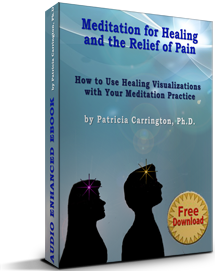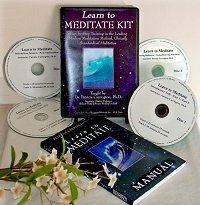Dr. Patricia Carrington's award winning meditation technique CSM (Clinically Standardized Meditation) is a clinically sensitive meditation method developed by the Medical Department of New York Telephone Company and used by numerous medical institutions, organizations, and individuals worldwide. For information click here.
Meditating to Increase Creativity
Increased Stamina with Meditation
Patricia Carrington, Ph.D.
Author of “The Book of Meditation”
Another link between meditation and creativity lies in a different realm. Meditation may contribute to the stamina of the artist, to her ability to sustain long periods of creative work. Here the results are clearly promising, although they are entirely anecdotal; I know of no formal studies in this area.
Arnold Schulman, the successful screenwriter and playwright and twice an Academy Award nominee, is an interesting example of this since he bases his method of writing on meditation. He has practiced Zazen meditation much of his life, having studied with an outstanding Zen master, Miura Roshi, head of the Rinzai sect in Japan. The Rinzai school of Zen Buddhism is famed for its use of koans in achieving enlightenment
Schulman originally learned meditation in order to cope with his problems in writing. In an interview with me he described himself before beginning to practice meditation as having been disorganized, inept, undisciplined and ‘chaotic’ when writing. He followed no logical work sequence. He would often stay up all night writing and then sleep all day. He was frequently unable to get started for days on end and had no orderly work habits. Already a successful writer at twenty-three years of age, he realized then that he actually could not continue writing if he did not change his approach to work, which was, he says, filling him with self-contempt. He experienced growing depression. Schulman’s psychoanalysis was helping him with some other problems but could not seem to bring his writing under control.
Accordingly he cast about for auxiliary answers. First, he taught himself to concentrate thoroughly on one thing at a time. He found the ability to exert a gentle, firm control over his mind to be the first thing which brought about a change in his approach to work. He now seemed to have a handle on the creative process and could begin to shape it to his own ends. He then went deeper, commencing to work with teachers of meditation and subjecting himself to the rigorous discipline of classical Zazen training. Meditation has subsequently become a way of life for him. As he puts it, ‘I could no more do without meditation than I could do without air or food. It has become essential.’ By this he does not mean that he is hooked on it, but that it is so inwardly strengthening that denying it to himself is inconceivable.
Schulman regularly programs his writing efforts to take place in a meditative mood. His work is always done sitting on the floor in a Half-lotus position. He works on a low table a few inches off the floor, writing either by hand or on an electric typewriter. Every night before going to bed, he sits in a semi-meditative state and reviews the story he is working on up to the point where he stopped writing, then he respectfully requests his ‘unconscious’ to have the next sequence ready the following morning or at midnight or at four in the morning – whenever he plans to begin work again (it is, he says, important to give an exact time).* Having done this with complete faith that the unconscious, a ‘loyal servant’ whom he treats with the utmost gentleness and dignity, will fulfill his request (an attitude toward work which he learned from a teacher of Raja Yoga), he then dismisses the problem from his mind and usually goes immediately to bed and to sleep. At the time he told me about this he no longer had to sit in the meditative position to do this. It had become so engrained a pattern that he now could direct his next day’s writing while in bed, the very last thing before dropping off to sleep.
When Schulman starts working in the morning, he unthinkingly begins writing. He does not know what will come, but simply ‘lets it happen’. The new sequence invariably presents itself in full as the writing unfolds and, when it does, he accepts it completely and unquestioningly. Later, in the editorial stage of his work, he will view it critically and decide how ‘good’ or complete an answer it was.
When working on a screenplay, he sleeps at the most three or four hours a night, and when awake works continuously with only brief breaks from the routine. After rising from sleep he always meditates for one full hour. Later he may do some Raja Yoga or some asanas (Yoga postures) if he feels tired. A half-hour of these postures, he claims, will substitute fully for sleep. He works sitting in a half-lotus position and maintaining to the greatest degree possible his meditative mood. This enables him to establish a ‘direct pipeline to the unconscious’. His words flow forth onto the paper, ‘mindlessly and fully’. He describes this phase of work as ‘achieving orbit’.
The problems of creativity are, Schulman feels, much like the problems of space travel. One must first get enough thrust to break out of the atmosphere into space. ‘I can only function when in orbit,’ he says. His means of pushing off the launching pad and breaking through is meditation. Not only does he begin his day with a long meditation, but when there is any interruption whatsoever (such as a phone call) he brings himself back into the creative mood by meditating once more, perhaps this time for fifteen or twenty minutes.
His workday thus involves a series of meditations as needed. This way he is able to sustain as much as twenty hours of highly creative work at a time. He does this without fatigue and in an almost unbroken rhythm until his writing assignment is completed. He explains that he must sweep through to the conclusion of any creative project ‘all in one breath’. In addition to enabling him to sustain this unusual productivity, Schulman feels meditation has assisted him in his work by eliminating the paralyzing anxiety a writer so often feels when faced with a blank page; the fear that can lead to endless postponement. Because meditation is not working with the conscious, logical, critical mind, he thinks this eliminates the prejudgment and fear of failure that can cause writer’s block. In the meditative mood the writing flows – clearly, openly, effortlessly – and without anxiety.
It is important to remember, however, that Schulman’s unorthodox use of meditation was undertaken under the supervision of highly skilled meditation teachers with whom he had worked for many years. As discussed in articles elsewhere on this site, it is not advisable and can in fact be dangerous for a person to meditate for long periods of time in a single day if this practice is not carefully supervised by a highly experienced teacher.
We might consider this sustaining aspect of meditation an indirect contribution to creativity. It is an important way in which meditation can assist the creative act. For some people meditation fosters the opening-up of unrealized potentials. There still remains, however, the question of which people it will do this for and under what circumstances. When is meditation effective and when not? We will explore these problems further.
* This is Schulman’s own system. Others might disagree with his procedures or even with this use of meditation.

